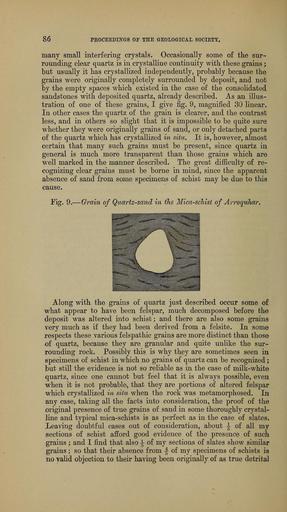MAKE A MEME
View Large Image

| View Original: | The_Quarterly_journal_of_the_Geological_Society_of_London_(12960682974).jpg (1174x2093) | |||
| Download: | Original | Medium | Small | Thumb |
| Courtesy of: | commons.wikimedia.org | More Like This | ||
| Keywords: The Quarterly journal of the Geological Society of London (12960682974).jpg 86 <br> PKOCEEDINGS OF THE GEOLOGICAL SOCIETY <br> many small interfering crystals Occasionally some of the sur- <br> rounding clear quartz is in crystalline continuity with these grains ; <br> but usually it has crystallized independently probably because the <br> grains were originally completely surrounded by deposit and not <br> by the empty spaces which existed in the case of the consolidated <br> sandstones with deposited quartz already described As an illus- <br> tration of one of these grains I give fig 9 magnified 30 linear <br> In other cases the quartz of the grain is clearer and the contrast <br> less and in others so slight that it is impossible to be quite sure <br> whether they were originally grains of sand or only detached parts <br> of the quartz which has crystallized in situ It is however almost <br> certain that many such grains must be present since quartz in <br> general is much more transparent than those grains which are <br> well marked in the manner described The great difficulty of re- <br> cognizing clear grains must be borne in mind since the apparent <br> absence of sand from some specimens of schist may be due to this <br> cause <br> Fig 9 � Grain of Quartz-sand in tJie Mica-scMst of ArroquTiar <br> Along with the grains of quartz just described occur some of <br> what appear to have been felspar much decomposed before the <br> deposit was altered into schist; and there are also some grains <br> very much as if they had been derived from a felsite In some <br> respects these various felspathic grains are more distinct than those <br> of quartz because they are granular and quite unlike the sur- <br> rounding rock Possibly this is why they are sometimes seen in <br> specimens of schist in which no grains of quartz can be recognized ; <br> but still the evidence is not so rehable as in the case of milk-white <br> quartz since one cannot but feel that it is always possible even <br> when it is not probable that they are portions of altered felspar <br> which crystallized in situ when the rock was metamorphosed In <br> any case taking all the facts into consideration the proof of the <br> original presence of true grains of sand in some thoroughly crystal- <br> line and typical mica-schists is as perfect as in the case of slates <br> Leaving doubtful cases out of consideration about i of all my <br> sections of schist afford good evidence of the presence of such <br> grains ; and I find that also of my sections of slates show similar <br> grains ; so that their absence from - of my specimens of schists is <br> no valid objection to their having been originally of as true detrital 36091173 111264 51125 Page 86 Text 36 http //www biodiversitylibrary org/page/36091173 1880 Geological Society of London Biodiversity Heritage Library The Quarterly journal of the Geological Society of London v 36 1880 Geology Periodicals Smithsonian Libraries bhl page 36091173 dc identifier http //biodiversitylibrary org/page/36091173 smithsonian libraries Information field Flickr posted date ISOdate 2014-03-06 Check categories 2015 August 26 CC-BY-2 0 BioDivLibrary https //flickr com/photos/61021753 N02/12960682974 2015-08-26 15 55 37 cc-by-2 0 PD-old-70-1923 The Quarterly journal of the Geological Society of London 1880 Photos uploaded from Flickr by Fæ using a script | ||||